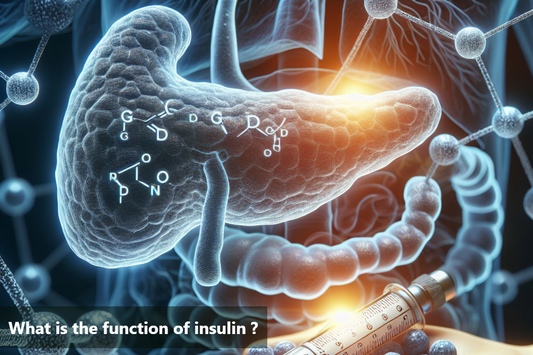Prediabetes is a term that many have heard, though its full implications are often less understood. It represents a crucial stage where blood sugar levels are elevated beyond normal ranges but not high enough to be classified as diabetes. This stage is particularly significant as it acts as a wake-up call, signaling the need for lifestyle modifications to prevent the transition to full-blown diabetes.
Many individuals may be teetering on the edge of prediabetes without being aware of this potential threat to their health.
As I explored the meaning of prediabetes, I realized the critical importance of raising awareness about this silent precursor to diabetes. Understanding prediabetes is key because it empowers you with knowledge. In the following sections, we will delve into a detailed discussion about prediabetes. We'll examine its significance, the importance of early detection, and the strategies to prevent it from progressing to diabetes. Let's embark on a journey to demystify prediabetes and arm ourselves with information that enables us to make informed health decisions.
Understanding Prediabetes
Understanding prediabetes is like figuring out an important health puzzle. Simply put, it's a condition where the sugar levels in your blood are higher than usual but haven't reached the diabetes stage yet. Now, let's talk about signs – those subtle messages our bodies send us. Prediabetes often doesn't show clear symptoms, making it a silent but important step toward type 2 diabetes.To really grasp prediabetes, it's crucial to know its main signs. Pay attention to your body's messages – like feeling more thirsty, peeing more often, and being unusually tired. These seemingly harmless signs could be the first clues of prediabetes, telling us to take notice. However, it's important to note that many people with prediabetes may not feel any symptoms at all. That's why it's key to understand risk factors.
Prediabetes isn't the same for everyone. It can come from a mix of things – like family history, lifestyle choices, and age. If diabetes runs in your family or you have a sedentary lifestyle, your risk goes up. Now, here's the important part – having prediabetes doesn't guarantee you'll get diabetes. It's a chance to make changes and improve your health.
Finding out if you have prediabetes involves a simple blood test, usually checking fasting blood sugar levels. Knowing about these tests gives us the tools to find prediabetes early. Remember, being aware is our best friend on this health journey. So, let's explore the details of prediabetes signs, risk factors, and diagnosis to give ourselves and those around us the knowledge to navigate this health path.
Risk Factors and Causes
Exploring the reasons for the risk of prediabetes is like figuring out the special code that affects our health journey. It's not just one thing, but a mix of stuff that can make the chances of having prediabetes higher. Let's break down these things to get a clearer picture.
The way we live plays a big part in the prediabetes story. Sitting a lot and eating not-so-healthy foods can raise the risk. Imagine this: sitting for a long time every day and eating a lot of sugary processed foods – a mix that could lead to prediabetes. It's not about being perfect, but about thinking about the choices we make.
Genes are also part of this complex situation. If people in your family have diabetes, you might be more likely to have it too. But it's not set in stone; it's a sign to take action. Knowing if diabetes runs in your family helps you make smart choices about how you live.
Age matters when it comes to prediabetes. As we get older, our bodies might slow down, making us more likely to have trouble with insulin. But here's the thing – age is just one part of the puzzle. The way we live can make a difference and balance out the effects of getting older on our health.
Other things, like hormone issues such as polycystic ovary syndrome (PCOS), can also make the risk higher. Understanding all these different causes is like having a map to navigate the tricky world of prediabetes risks.
So, when we talk about what causes prediabetes and the things that make it more likely, it's not about blaming anyone. It's about knowing what we can control and doing things to lower the chances. Let's go through these details together, armed with the knowledge to make smart choices about our health.
Prevention and Management
Now that we've figured out how to handle prediabetes, let's talk about preventing and managing it. It's not just about understanding; it's about using that understanding to stay away from the diabetes danger zone.
To prevent prediabetes, focus on changing your lifestyle. Small, regular changes can make a big difference. For example, replace sugary drinks with water or add a brisk walk to your daily routine. These simple adjustments can help prevent prediabetes.
What you eat is crucial in preventing prediabetes. Choose a balanced diet with lots of fiber, whole grains, and lean proteins. It's not about giving up things you like, but about making choices that keep your body healthy. Think of it as teaming up with your future self to give your body the right nutrients.
Regular exercise is not just a suggestion; it's a key part of managing prediabetes. Doing activities you enjoy, like dancing, biking, or taking a stroll in the park, can make a big difference. Exercise is not a punishment; it's a way to celebrate what your body can do.
Managing your weight is closely connected to preventing and managing prediabetes. If you need to, losing extra weight can significantly lower the risk. It's not about meeting societal expectations but finding a weight that supports your overall well-being.
Checking your blood sugar levels regularly is a proactive way to manage prediabetes. It's not only for those with diabetes; it's a tool for everyone to stay aware. Knowledge is power, and in this case, it's the power to step in and make corrections.
In summary, preventing and managing prediabetes is about adding healthier habits to our daily lives. It's not a big, sudden change but a series of purposeful, lasting choices. As we go through these practical tips, let's remember that prevention is a gift to ourselves – a promise to a healthier, more lively future.
Keeping track of your health
As we finish talking about prediabetes, let's focus on the main ideas that can guide us toward better health. Prediabetes is something that could affect many people, and understanding it helps us take control.
Firstly, we looked into what prediabetes is – a crucial stage where blood sugar levels give a warning, telling us to be careful. Since there are no clear signs, finding it early through regular check-ups and staying aware is important.
Understanding prediabetes means noticing its subtle signs and recognizing various factors that can contribute. It's not the same for everyone, but a personalized plan that considers genetics, lifestyle choices, and age.
Factors that increase the risk don't mean it's our fate; they're signals to make changes. Lifestyle changes are key to preventing and managing prediabetes. It's about making intentional choices in what we eat and how we stay active to protect ourselves from getting type 2 diabetes.
Prevention is not a distant goal; it's about daily choices. Small, lasting changes in our diet, regular exercise, and managing weight all add up to a healthier future. Checking blood sugar levels is a useful tool, not just for those with diabetes but for anyone wanting to stay healthy.
In summary, going through prediabetes is a call to take action. It's about putting our health first, being aware, and using our power to control our destinies. Early detection and lifestyle changes aren't just suggestions; they're the keys to avoiding type 2 diabetes. So, let's start today – a step toward a healthier, more lively tomorrow. Your health is your most valuable asset; take care of it, nurture it, and let it be the base for a thriving future.
This Blog post is an initiative by DiabeSmart, to provide accurate and Nutritionist / Doctor approved information related to Diabetes. DiabeSmart is India's first Food brand designed specifically for Diabetics, that has been clinically tested on Diabetics and Pre-Diabetics to deliver 55% - 70% lower Sugar spikes. DiabeSmart is part of Lo! Foods - India's leading brand for Everyday Functional Health foods.











